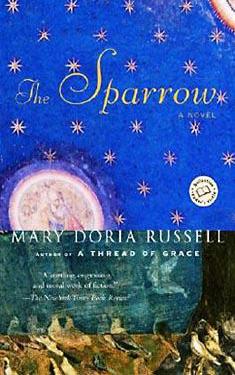Mary Doria Russell
Completed 10/15/2013, Reviewed 11/5/2013
5 stars
Despite being an agnostic, I love SF and Fantasy that
questions, critiques, or parodies religion.
Some of my favorite novels are “Canticle for Leibowitz,” Case ofConscience, and “Live from Golgotha ” by Gore
Vidal. So when I looked for more books
to read for the WOGF challenge, I searched in the WWEnd database using the tag
“theological.” Once again, I found a
gem.
 “The Sparrow” transposes the experience of the New World
Jesuit missions to the genre of SF. Fr.
Emilio Sandoz, a Jesuit priest leads the first mission to a planet which seems
to harbor intelligent life. Something goes
terribly wrong and leaves the priest the only survivor, demoralized and in a
crisis of faith.
“The Sparrow” transposes the experience of the New World
Jesuit missions to the genre of SF. Fr.
Emilio Sandoz, a Jesuit priest leads the first mission to a planet which seems
to harbor intelligent life. Something goes
terribly wrong and leaves the priest the only survivor, demoralized and in a
crisis of faith.
The premise of “The Sparrow” may seem absurd by today’s
standards. We don’t expect the Catholic
Church to be the first to send a mission to an extraterrestrial world. Placed in a historical context, it is not
absurd at all. This happened throughout
the European exploration of the Americas ,
as well as the non-Christianized regions of the other continents. This book takes that premise and places is in
a contemporary context with our modern sense of cultural sensitivity. The result provides the reader with a group
of very likable, honorable, and by most definitions, good people put into a morally
ambiguous and deadly situation.
I loved the prose of the book. It was beautifully written. I found the narrative structure to be quite
compelling. The history of the mission is
told parallel to the trials of the surviving Fr Sandoz. It is another book where every word seems
important and every paragraph necessary.
I also loved the characterizations. The people on the mission were drawn in such
detail and with such love, that I could relate them to specific people I knew
from my college days when I hung out with a group of left-wing radicals which
spanned the spectrum from radical nuns to philosophical scientists. During
the ‘80s, all these people came together to form an intentional community of
support for each other and care for their fellow human beings in a spirit of
peace and justice. I read several
reviews of the book that insisted that these characters were too good to be
true. My experience is that these people
exist, and find each other and God in the world in profound ways.
What would it be like if there were more than one sentient
species on a planet? There must be some
novels that have speculated on this concept, but this is my first encounter
with it. Uplift stories don’t even come
close. Russell takes the premise of multiple
sentient species interacting on a planet and forces us into a moral
quandary. How will we interact with
extraterrestrial life where evolution has created a morality so radically
different than ours? The answer may be difficult
and even abhorrent, but it is a question we will probably have to face.
Despite my absolute love of this book, I had a few issues
with it. It saddened me that Russell’s
Church of the future is still run by celibate males, and that there is no
feminine influence at the highest levels.
I also found it disheartening that the one gay character only came out
to one other character. The way he came
out reminded me of a quote by Montgomery McNeil in the movie “Fame,” “Never
being happy isn’t the same as being unhappy.
Is it?”
Russell uses a lot of archetypes and common Catholic
iconography in the formation of her main characters. Fr Sandoz is the saint of classic
hagiography. He is a sinner who has a
conversion experience and goes out to live the gospel. In the tradition of the mystic saints, and as
the main plot of the book, he experiences an existential crisis in a dark night
of the soul. Fr Yarbrough can be likened
to St Peter, the rock, the commander and pragmatist of the mission, carrying
his rifle like Peter carrying his sword at the Garden of Gethsemane
The big reveal at the end feeds into the existential dilemma
of Fr Sandoz: if God exists, then how can evil be God’s will? If God doesn’t exist, then isn’t this
deplorable situation the fruit of my own choices? Both questions lead to despair and
hopelessness. It reminds me of the
commonly thrown-about phrase, “The path to hell is paved with good intentions.” How do we discern which good intentions do
not lead to hell? Even if we think we
have a well-formed conscience and believe we are doing God’s will, we may still
be making the wrong decisions.
I made the mistake of reading a lot of reader reviews of
this book, and had to hold myself from speaking to a lot of the criticisms. One or two slipped out anyway. I think the amount of criticism signifies
that the book accomplished its goal: to create a dialogue about the nature of
moral ambiguity in a beautifully written piece of science fiction.
This is a five-star book.
This is also the longest review I’ve ever written. “The Sparrow” evoked a lot of feelings and
ideas. Clearly, I had some issues with
it, but ultimately, I loved it. I think
great literature asks profound questions and leaves us with ambiguity. The pursuit of the answers is beautifully
summarized in this quote, “If we keep demanding that God yield up His answers,
perhaps some day we will understand them.
And then we will be something more than clever apes, and we shall dance
with God.”
No comments:
Post a Comment